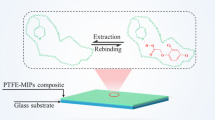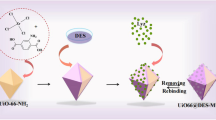Abstract
Novel molecularly imprinted polymers (MIPs) based on denatured casein nanoparticle (DCP)-stabilized Pickering emulsions were developed for the first time. Casein, a phosphoprotein, is the main protein in milk. In this work, DCPs were solely used as Pickering-type interfacial emulsifiers for fabrication of MIPs for the selective recognition of proteins for the first time. DCPs were prepared by acidification and heat denaturation (at 80 °C) of casein. Their dispersions have satisfactory colloidal stability over a wide pH range. The DCPs acted as natural, food-grade, and edible interfacial emulsifiers, and adsorbed at the oil–water interface to form Pickering emulsions. After the polymerization of monomers, the template protein was removed by elution. During the elution, the interfacial DCPs were also removed, allowing more imprinted cavities to become exposed. The interfacial imprinting technology causes nearly all the imprinted sites to locate on the surface of the polymeric material. Therefore, the MIPs obtained exhibit fast rebinding and excellent specific recognition ability toward the analytes. Overall, this work provides a promising method for designing and fabricating natural-protein-based structured emulsions to prepare MIPs and thus offers new insight into protein separation and purification.

Pickering emulsions stabilized by denatured casein particles.









Similar content being viewed by others
References
Lv YQ, Tan TW, Svec F. Molecular imprinting of proteins in polymers attached to the surface of nanomaterials for selective recognition of biomacromolecules. Biotechnol Adv. 2013;31:1172–86.
Mirata F, Resmini M. Molecularly imprinted polymers for catalysis and synthesis. Adv Biochem Eng Biotechnol. 2015;150:107–29.
Haupt K, Mosbach K. Molecularly imprinted polymers and their use in biomimetic sensors. Chem Rev. 2000;100:2495–504.
Chen L, Xu S, Li J. Recent advances in molecular imprinted technology: current status, challenges and highlighted applications. Chem Soc Rev. 2011;40:2922–42.
Luo J, Ma Q, Wei W, Zhu Y, Liu R, Liu X. Synthesis of water-dispersible molecularly imprinted electroactive nanoparticles for the sensitive and selective paracetamol detection. ACS Appl Mater Interfaces. 2016;8:21028–38.
Chunta S, Suedee R, Lieberzeit PA. Low-density lipoprotein sensor based on molecularly imprinted polymer. Anal Chem. 2016;88:1419–25.
Hussain M, Kotoya K, Lieberzeit PA. Molecularly imprinted polymer nanoparticles for formaldehyde sensing with QCM. Sensors. 2016;16:1011-11.
Wulff G. Enzyme-like catalysis by molecularly imprinted polymers. Chem Rev. 2002;102:1–28.
Sun Y, Chen J, Li Y, Li H, Zhu X, Hu Y, et al. Bio-inspired magnetic molecularly imprinted polymers based on Pickering emulsion for selective protein recognition. New J Chem. 2016;40:8745–52.
Dai J, He J, Xie A, Gao L, Pan J, Chen X, et al. Novel pitaya-inspired well-defined core-shell nanospheres with ultrathin surface imprinted nanofilm for magnetic mesoporous nanosilica for highly efficient chloramphenicol removal. Chem Eng J. 2016;284:812–22.
Pellizzoni E, Tommasini M, Marangon E, Rizzolio F, Saito G, Benedetti F, et al. Fluorescent molecularly imprinted nanogels for the detection of anticancer drugs in human plasma. Biosens Bioelectron. 2016;86:913–9.
Ray JV, Mirata F, Perollier C, Arotcarena M, Bayoudh S, Resmini M. Smart coumarin-tagged imprinted polymers for the rapid detection of tamoxifem. Anal Bioanal Chem. 2016;408:1855–61.
Urraca JL, Aureliano CSA, Schillinger E, Esselmann H, Wiltfang J, Sellergren B. Polymeric complements to the Alzheimer’s disease biomarker β–amyloid isoforms Aβ1-40 and Aβ1-42 for blood serum analysis under denaturing conditions. J Am Chem Soc. 2011;33:9220–3.
Chunta S, Singsanan S, Suedee R, Lieberzeit PA. Sensor array based on molecularly imprinted polymers for simultaneous detection of lipoproteins. Proceedings. 2017;1:510-10
Li S, Cao S, Whitcombe MJ, Piletsky SA. Size matters: challenges in imprinting macromolecules. Prog Polym Sci. 2014;39:145–63.
Luo J, Huang J, Cong J, Wei W, Liu X. Double recognition and selective extraction of glycoprotein based on the molecular imprinted graphene oxide and boronate affinity. ACS Appl Mater Interfaces. 2017;9:7735–44.
Verheyen E, Schillemans JP, van Wijk M, Demenies MA, Hennink WE, van Nostrum CF. Challenges for the effective molecular imprinting of proteins. Biomaterials. 2011;32:3008–20.
Zhou T, Zhang K, Kamra T, Bulow L, Ye L. Preparation of protein imprinted polymer beads by Pickering emulsion polymerization. J Mater Chem. 2015;3:1254–60.
Shen X, Zhou T, Ye L. Molecular imprinting of protein in Pickering emulsion. Chem Commun. 2012;48:8198–200.
Hoshino Y, Koide H, Urakami T, Kanazawa H, Kodama T, Oku N, et al. Recognition, neutralization, and clearance of target peptides in the bloodstream of living mice by molecularly imprinted polymer nanoparticles: a plastic antibody. J Am Chem Soc. 2010;132:6644–5.
Ramsden W. Separation of solids in the surface-layers of solutions and ‘suspensions’ (Observations on surface-membranes bubbles, emulsions, and mechanical coagulation)–Preliminary account. Proc R Soc Lond. 1903;72:156–64.
Pickering SU. Emulsions. J Chem Soc Trans. 1907;81:2001–21.
Pan J, Liu J, Ma Y, Huang X, Zhang T, Chen X, et al. Wulff-type boronic acids suspended hierarchical porous polymeric monolith for the specific capture of cis-diol-containing flavone under neutral condition. Chem Eng J. 2017;317:317–30.
Tang J, Quinlan PJ, Tam KC. Stimuli-responsive Pickering emulsions: recent advances and potential application. Soft Matter. 2015;11:3512–29.
Tang J, Berry RM, Tam KC. Stimuli-responsive cellulose nanocrystals for surfactant-free oil harvesting. Biomacromolecules. 2016;17:1748–56.
Schrade A, Landfester K, Ziener U. Pickering-type stabilized nanoparticles by heterophase polymerization. Chem Soc Rev. 2013;42:6823–39.
Berton-Carabin CC, Schroen K. Pickering emulsions for food applications: background, trends, and challenges. Annu Rev Food Sci Technol. 2015;6:263–97.
Hussain MA, Liu H, Wang Q, Zhong F, Guo Q, Balamurugan S. Use of encapsulated bacteriophages to enhance farm to fork food safety. Crit Rev Food Sci Nutr. 2017;57:2801–10.
Zhou H, Shi T, Zhou X. Preparation of polystyrene/SiO2 microsphere via Pickering emulsion polymerization: Synergistic effect of SiO2 concentrations and initiators sorts. Appl Surf Sci. 2013;66:33–8.
Li Y, Sun Y, Chen J, Zhu X, Li H, Huang S, et al. Graphene oxide as a sacrificial material for fabricating molecularly imprinted polymers via Pickering emulsion polymerization. RSC Adv. 2016;6:74654–61.
Bon SAF, Colver PJ. Pickering miniemulsion polymerization using laponite clay as a stabilizer. Langmuir. 2007;23:8316–22.
Teixeira RFA, McKenzie HS, Boyd AA, Bon SAF. Pickering emulsion polymerization using laponite clay as stabilizer to prepare armored “soft” polymer latexes. Macromolecules. 2011;44:7415–22.
Sun Y, Li Y, Xu J, Huang L, Qiu T. Interconnectivity of macroporous molecularly imprinted polymers fabricated by hydroxyapatite-stabilized Pickering high internal phase emulsions-hydrogels for the selective recognition of protein. Colloids Surf B. 2017;155:142–9.
Wang X, Li J, Li Y, Liu L, Guan W. Emulsion-templated fully three-dimensional interconnected porous titania ceramics with excellent humidity sensing properties. Sensors Actuators B Chem. 2016;237:894–8.
Huo J, Marcello M, Garai A, Bradshaw D. MOF-polymer composite microcapsules derived from Pickering emulsions. Adv Mater. 2013;25:2717–22.
Luo ZY, Lyu SS, Fu YX, Heng Y, Mo DC. The Janus effect on superhydrophilic Cu mesh decorated with Ni-NiO/Ni(OH)2 core-shell nanoparticles for oil/water separation. Appl Surf Sci. 2017;409:431–7.
Liu X, Yi C, Zhu Y, Yang Y, Jiang J, Cui Z. Pickering emulsions stabilized by self-assembled colloidal particles of copolymers of P(St-alt-Man)-co-P(VM-alt-Man). J Colloid Interface Sci. 2010;351:315–22.
Sun Y, Zhong S. Nanoscale trifunctional bovine hemoglobin for fabricating molecularly imprinted polydopamine via Pickering emulsions-hydrogels polymerization. Colloids Surf B. 2017;159:131–8.
Lin Q, Liang R, Ye A, Singh H, Zhong F. Effects of calcium on lipid digestion in nanoemulsions stabilized by modified starch: implications for bioaccessibility of β-carotene. Food Hydrocoll. 2017;73:184–93.
Zhu W, Ma W, Li C, Pan J, Dai X, Gan M, et al. Magnetic molecularly imprinted microspheres via yeast stabilized Pickering emulsion polymerization for selective recognition of λ-cyhalothrin. Colloids Surf A Physicochem Eng Asp. 2014;453:27–36.
Wongkongkatep P, Manopwisedjaroen K, Tiposoth P, Archakunakorn S, Pongtharangkul T, Suphantharika M, et al. Bacteria interface Pickering emulsions stabilized by self-assembled bacteria-chitosan network. Langmuir. 2012;28:5729–36.
Qiu Y, Ma Z, Hu P. Environmentally benign magnetic chitosan/Fe3O4 composites as reductant and stabilizer for anchoring Au NPs and their catalytic reduction of 4-nitrophenol. J Mater Chem A. 2014;2:13471–8.
Tang J, Sisler J, Grishkewich N, Tam KC. Functionalization of cellulose nanocrystals for advanced applications. J Colloid Interface Sci. 2017;495:397–409.
Han S, Zhang H, Xie Y, Liu L, Shan C, Li X, et al. Application of cow milk-derived carbon dots/Ag NPs composite as the antibacterial agent. Appl Surf Sci. 2015;328:368–73.
Dalgleish DG. On the structural models of bovine casein micelles – review and possible improvements. Soft Matter. 2011;7:2265–72.
Liu F, Tang CH. Soy protein nanoparticle aggregates as Pickering stabilizers for oil-in-water emulsions. J Agric Food Chem. 2013;61:8888–98.
Feng Y, Lee Y. Surface modification of zein colloidal particles with sodium caseinate to stabilize oil-in-water Pickering emulsion. Food Hydrocoll. 2016;56:292–302.
Donato L, Alexander M, Dalgleish DG. Acid gelation in heated and unheated milks: interactions between serum protein complexes and the surfaces of casein micelles. J Agric Food Chem. 2007;55:4160–8.
Yaginuma Y, Kijima T. Effect of pH on rheological properties of microcrystalline cellulose dispersions. J Dispers Sci Technol. 2006;27:365–70.
de Folter JW, van Ruijven MWM, Velikov KP. Oil-in-water Pickering emulsions stabilized by colloidal particles from the water-insoluble protein zein. Soft Matter. 2012;8:6807–15.
Vignati E, Piazza R, Lockhart TP. Pickering emulsions: Interfacial tension, colloidal layer morphology, and trapped-particle motion. Langmuir. 2003;19:6650–6.
Fan X, Niu L, Wu Y, Cheng J, Yang Z. Assembly route toward raspberry-like composite particles and their controlled surface wettability through varied dual-size binary roughness. Appl Surf Sci. 2015;332:393–402.
Gao R, Zhang L, Hao Y, Cui X, Liu D, Zhang M, et al. One-step preparation of magnetic imprinted nanoparticles adopting dopamine-cupric ion as a co-monomer for the specific recognition of bovine hemoglobin. J Sep Sci. 2015;38:3568.
Acknowledgements
This work was financially supported by the National Natural Science Foundation of China (no. 21576295) and Hunan Provincial Innovation Foundation for Postgraduate (CX2017B043).
Author information
Authors and Affiliations
Corresponding author
Ethics declarations
This article does not contain any studies with human participants or animals performed by any of the authors.
Conflict of interest
The authors declare that they have no competing interests.
Electronic supplementary material
ESM 1
(PDF 237 kb)
Rights and permissions
About this article
Cite this article
Sun, Y., Zhong, S. Molecularly imprinted polymers fabricated via Pickering emulsions stabilized solely by food-grade casein colloidal nanoparticles for selective protein recognition. Anal Bioanal Chem 410, 3133–3143 (2018). https://doi.org/10.1007/s00216-018-1006-x
Received:
Revised:
Accepted:
Published:
Issue Date:
DOI: https://doi.org/10.1007/s00216-018-1006-x




